Russia’s delegation demands Ukraine abandon four oblasts while rejecting unconditional ceasefire, as military commanders reshuffle and 909 fallen soldiers return home
Summary of the Day – May 16, 2025
Ukrainian and Russian delegations met for nearly two hours in Istanbul’s Dolmabahçe Palace, ending the first direct negotiations in three years with familiar deadlock and renewed Russian maximalism. Putin’s no-show, sending propaganda architect Vladimir Medinsky instead, signaled Moscow views these talks as theater rather than genuine peace efforts. Russia demanded Ukraine abandon four partially occupied oblasts entirely while rejecting an unconditional ceasefire. Yet one breakthrough emerged: an agreement to exchange 1,000 prisoners of war from each side—potentially the largest such swap of the conflict. Meanwhile, Putin reshuffled his military command, promoting generals who specialized in grinding siege warfare, as Ukraine repatriated 909 fallen soldiers and economic data revealed Russia’s war economy slowing significantly.
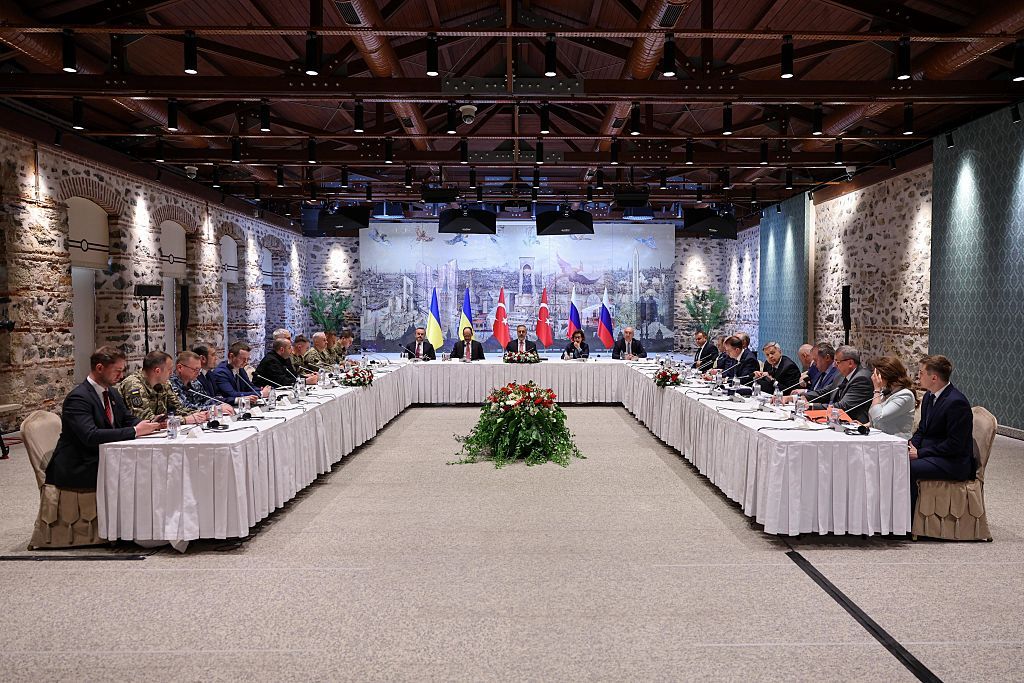
Turkish Foreign Minister Hakan Fidan chairs Turkiye-Russia-Ukraine Trilateral Meeting at Dolmabahce Presidential Office in Istanbul, Turkiye. (Arda Kucukkaya / Anadolu via Getty Images)
The Delegation That Wasn’t: Putin’s No-Show Speaks Volumes
The most telling moment of the Istanbul talks occurred before they even began. President Volodymyr Zelensky had personally flown to Turkey on May 15, accepting Putin’s own proposal for face-to-face negotiations. The Ukrainian leader even invited Putin to meet him directly in Istanbul, offering what would have been the first encounter between the two presidents since Russia’s full-scale invasion began.
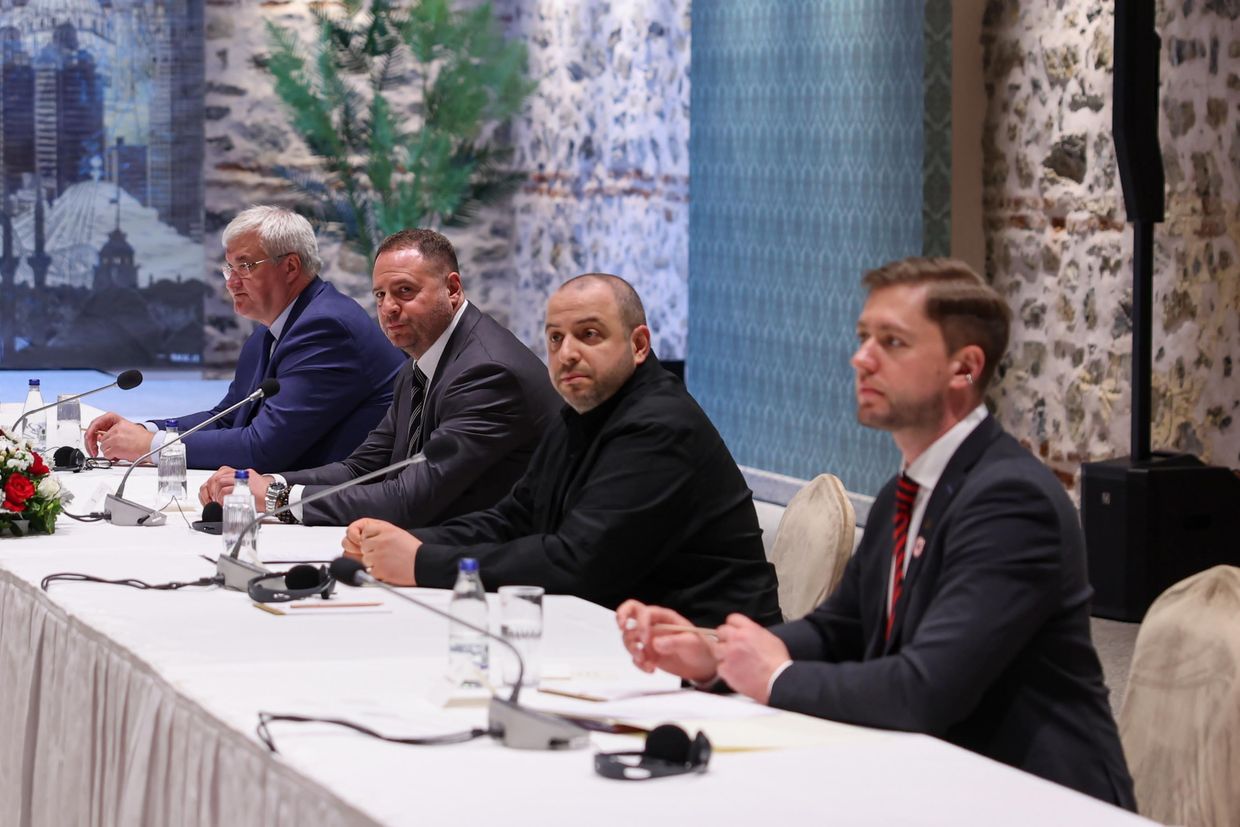
A Ukrainian delegation attends the Turkey-U.S.-Ukraine trilateral meeting chaired by Turkish Foreign Minister Hakan Fidan in Istanbul, Turkey. (Arda Kucukkaya/Turkish Foreign Ministry via Getty Images)
Putin’s response was to stay home and dispatch Vladimir Medinsky, a former culture minister turned presidential aide whose primary qualification appears to be his authorship of propaganda-laden history textbooks used to indoctrinate Russian children. The Russian delegation included deputy ministers and intelligence officials—competent bureaucrats, perhaps, but none with the authority to make the life-and-death decisions that peace requires.
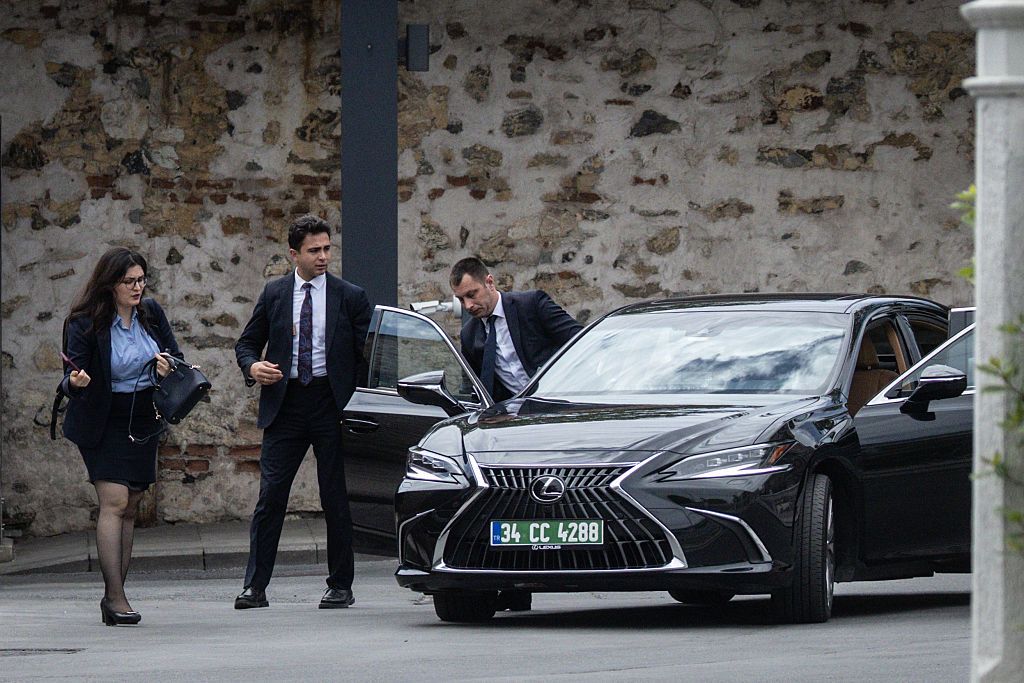
A car carrying Russian officials departs the office of Turkish President in Dolmabahce Palace during Ukraine-Russia peace talks at the office of Turkish President in Dolmabahce Palace in Istanbul, Turkey. (Chris McGrath / Getty Images)
“I feel disrespect from Russia,” Zelensky told reporters after meeting Turkish President Tayyip Erdogan in Ankara. “No meeting time, no agenda, no high-level delegation—this is personal disrespect. To Erdogan, to Trump.”
The choreography spoke louder than any communiqué. While Zelensky waited in Ankara, the Russian team sat in Istanbul with no Ukrainian counterparts in sight. Some 200 reporters milled around the Dolmabahçe Palace, witnesses to a diplomatic anticlimax that had been months in the making.
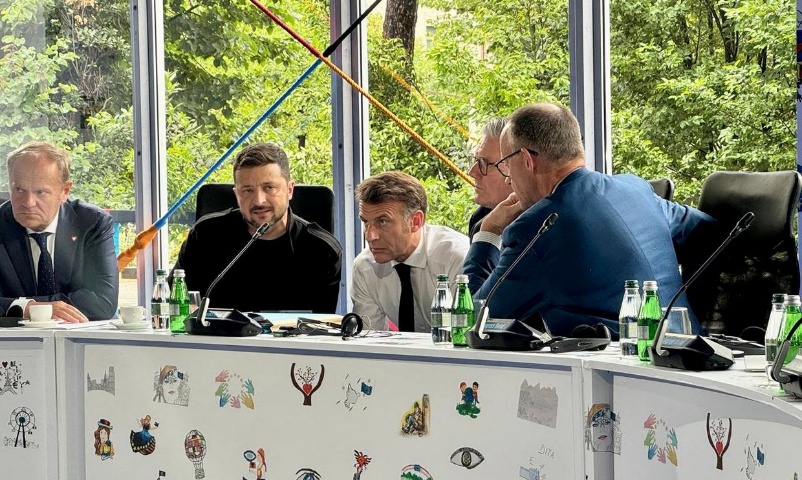
President Volodymyr Zelensky and several top European leaders held a phone call with U.S. President Donald Trump, following the conclusion of peace talks between Ukraine and Russia in Istanbul. (Presidential Office chief Andriy Yermak / Telegram)
Unrealistic Demands: Russia’s Territorial Maximalism Laid Bare
When the delegations finally met on May 16, the substance proved as disappointing as the optics. Ukrainian sources briefed on the talks revealed that Russia’s demands went “far beyond” anything previously discussed—a collection of ultimatums that would effectively require Ukraine’s capitulation.
Moscow insisted Ukraine withdraw completely from Donetsk, Luhansk, Zaporizhzhia, and Kherson oblasts—territory Russia claims to have annexed but does not fully control. The demand echoed Putin’s earliest war aims from 2022, when Russian forces were advancing on Kyiv and Ukraine’s survival seemed uncertain.
More provocatively, Ukrainian diplomatic sources reported that Russia also threatened to seize Kharkiv and Sumy oblasts to create a “security zone”—formalizing territorial claims that had previously remained informal. Oliver Carroll of The Economist reported that Russian negotiators specifically mentioned annexing Sumy Oblast, a threat that transforms defensive rhetoric into naked expansionism.
“The Russians, as predicted, have demonstrated complete unreadiness for real negotiations,” said Yaroslav Yurchyshyn, a lawmaker from the Holos party. “By again refusing a 30-day unconditional ceasefire, it means that Russian authorities are just playing everyone for fools and taking the time to regroup.”
The Man Who Rewrites History: Medinsky’s Propaganda Portfolio
The choice of Vladimir Medinsky to lead Russia’s delegation was itself a message. Born in Ukraine’s Cherkasy Oblast, Medinsky rose through Putin’s system as a loyal servant willing to undertake any task—from rewriting school curricula to conducting sham peace negotiations.
As culture minister from 2012 to 2020, Medinsky oversaw the creation of history textbooks that portrays Ukraine’s 2014 EuroMaidan Revolution as a “military coup” and presents Russia’s aggression as justified defensive action. His work has been characterized by academics as pseudo-scientific propaganda designed to create “ideologically-driven citizens.”
“Medinsky has been monopolizing and controlling the process of writing curricula and school textbooks for 10 years,” said Serhii Zhukov, an analyst at the Kyiv-based Center for Strategic Communications and Information Security. “This is a person who is largely responsible in Russia for the ideological processing and indoctrination of children.”
Now under U.S. and Canadian sanctions for spreading disinformation about Russia’s aggression, Medinsky represents continuity with the failed 2022 talks—a deliberate choice by Putin to signal that Russia’s fundamental position remains unchanged.
One Bright Spot: The Promise of 1,000 for 1,000
Despite the diplomatic deadlock, the talks produced one concrete achievement that could bring relief to thousands of families. Defense Minister Rustem Umerov, who headed Ukraine’s delegation, announced that both sides had agreed to exchange 1,000 prisoners of war each—by far the largest such swap of the conflict.
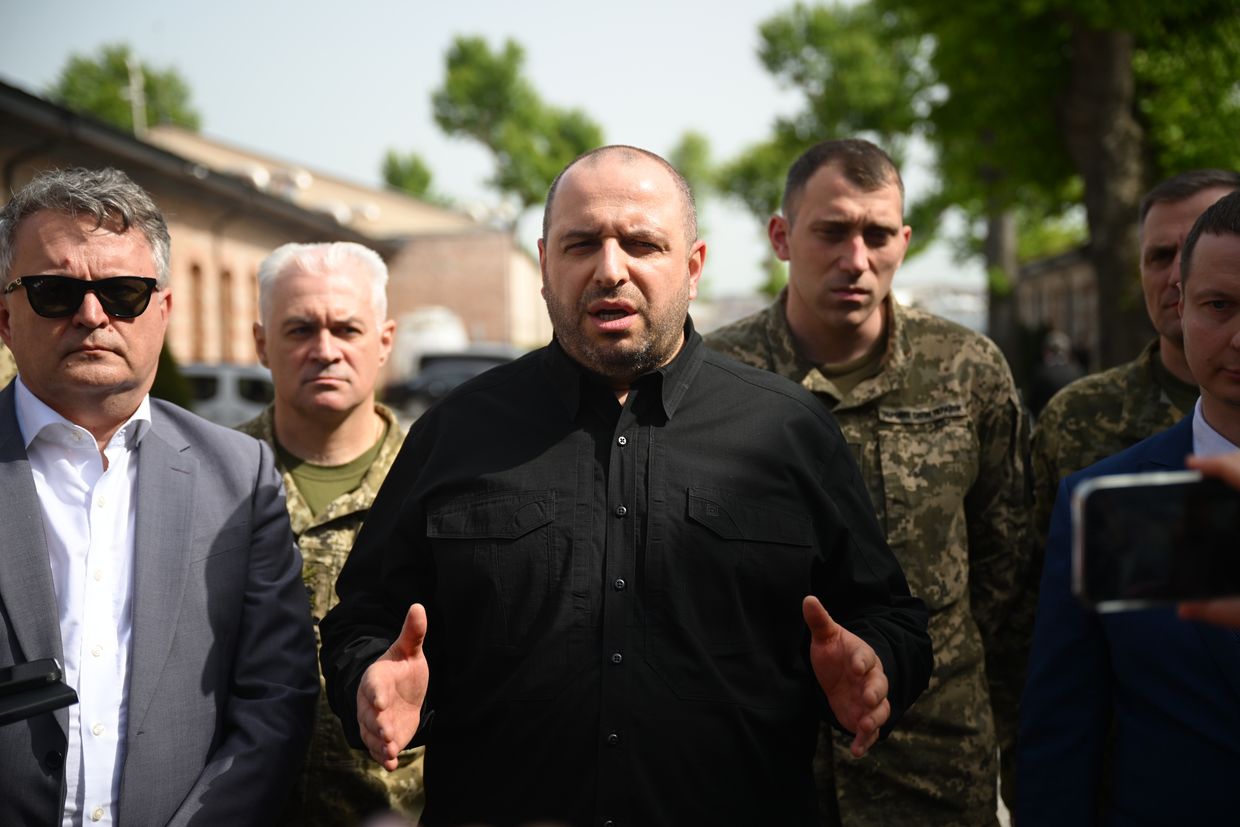
Ukrainian Defense Minister Rustem Umerov speaks to press after the trilateral meeting among Turkey, Russia, and Ukraine in Istanbul, Turkey (Arif Hudaverdi Yaman/Anadolu via Getty Images)
“We know the date, but we’re not going to say it yet,” Umerov told reporters, suggesting the exchange could happen soon. Vladimir Medinsky confirmed the agreement in comments to Russian state media, and Ukraine’s Deputy Defense Intelligence Chief Vadym Skybytskyi said work on prisoner lists would begin immediately.
The agreement represents a rare area of cooperation between the warring sides. Since Russia’s full-scale invasion began, more than 4,000 Ukrainian military personnel and civilians have been released from Russian captivity through regular exchanges. The most recent major swap occurred on May 6, when 205 Ukrainian servicemembers returned home.
For families on both sides, the prisoner exchange offers hope amid the diplomatic wreckage. Each name on those lists represents someone’s son or daughter, husband or wife, whose return could provide small comfort in a conflict that has torn apart countless lives.
The Commander Reshuffle: Russia Elevates Its Siege Strategists
While diplomats sparred in Istanbul, Putin was quietly reshaping his military leadership to reflect hard-won lessons from three years of grinding warfare. The promotion of Colonel General Andrey Mordvichev to Commander-in-Chief of Russian Ground Forces sent a clear signal about Russia’s strategic priorities.
Mordvichev’s elevation was no accident. As commander of the 8th Guards Combined Arms Army, he orchestrated the devastating siege of Mariupol in 2022—a campaign that killed tens of thousands of Ukrainian civilians but ultimately delivered Putin one of his few clear victories. More recently, Mordvichev oversaw the capture of Avdiivka in February 2024, employing the same grinding, attritional tactics that have become Russia’s signature approach.
The Ukrainian Security Service has accused Mordvichev of war crimes, noting that under his command, Russian forces systematically destroyed civilian infrastructure and committed atrocities against both civilians and military personnel. Yet from Putin’s perspective, Mordvichev represents results—a general who can take territory, however slowly and at whatever cost.
Putin also appointed Colonel General Valery Solodchuk as commander of Russia’s Central Military District, the formation responsible for the crucial Donbas front. Solodchuk earned his promotion through his leadership of the campaign to recapture Russian territory in Kursk Oblast, where he combined massed artillery, air strikes, and reportedly 10,000 North Korean troops to slowly grind down Ukrainian positions.
These appointments suggest Putin is institutionalizing the brutal lessons of the past three years: that Russia can win through sheer attrition, trading massive casualties for incremental territorial gains. It’s a strategy that treats soldiers as expendable resources and civilians as acceptable casualties—precisely the mindset that makes meaningful peace negotiations so difficult.
The Numbers Game: Russia’s Growing Military Presence
Ukrainian Commander-in-Chief Oleksandr Syrskyi revealed at the NATO-Ukraine Council on May 15 that Russia has deployed up to 640,000 soldiers in combat operations against Ukraine—a figure that underscores the conflict’s massive scale and Moscow’s continued commitment to military solutions.
This represents a steady increase from previous estimates. In November 2024, Ukrainian intelligence reported nearly 580,000 Russian troops engaged in combat; by March 2025, that number had risen to 620,000. The upward trend reflects Russia’s ability to sustain its war effort despite massive casualties and international sanctions.
As of May 15, Ukraine’s General Staff estimated that Russia had lost 970,590 troops since the full-scale invasion began—a staggering figure that includes killed, captured, wounded, and missing personnel. Independent verification of these numbers remains difficult, but Western intelligence agencies have broadly confirmed their plausibility.
The scale of these losses, combined with Russia’s continued ability to field new units, illustrates both the conflict’s brutality and Moscow’s apparent willingness to accept almost any cost to achieve its objectives. For Ukrainian soldiers watching these diplomatic efforts from their trenches, such numbers explain their skepticism about Russian peace overtures.
Ukraine’s Fallen Heroes: 909 Soldiers Return Home
While diplomats negotiated in Istanbul, Ukraine completed the somber task of bringing home 909 fallen soldiers from the frontlines and Russian morgues. The Coordination Headquarters for the Treatment of Prisoners of War announced the repatriation on May 16, marking another chapter in the conflict’s human toll.
The recovered bodies came from the war’s most intense combat zones: Donetsk, Luhansk, Zaporizhzhia, Sumy, and Kharkiv oblasts. Each represents a life cut short, dreams unfulfilled, families forever changed by a conflict that shows no signs of ending.
“Law enforcement officials together with expert institutions of the Interior Ministry will identify the victims as soon as possible,” the coordination headquarters announced. For many families, this process offers the only chance for closure—the opportunity to lay their loved ones to rest with dignity.
These regular repatriations of bodies have become a grim routine of the war, a reminder that while politicians debate ceasefires and territorial concessions, the dying continues. President Zelensky has acknowledged that over 46,000 Ukrainian soldiers have been killed since the invasion began, with 380,000 wounded—numbers that make abstract discussions of peace particularly urgent for those bearing the conflict’s costs.
Battlefield Realities: The F-16 Incident and Ongoing Combat
The day’s events were punctuated by a sobering reminder of the war’s continuing intensity. Ukraine’s Air Force reported losing contact with an F-16 fighter jet during combat operations, forcing the pilot to eject after destroying three Russian aerial targets and engaging a fourth.
The incident highlighted both Ukraine’s growing capabilities and the persistent dangers facing its forces. F-16s, provided by Netherlands and Denmark, have become crucial tools in Ukraine’s effort to counter Russian missile and drone attacks. Yet the loss also recalled previous incidents, including the death of pilot Oleksii Mes in August 2024 and Pavlo Ivanov in April 2025.
Meanwhile, Russian forces continued their grinding advances across multiple fronts. Geolocated footage confirmed Russian gains near Toretsk, Pokrovsk, and in the Zaporizhia direction—incremental progress that belies the dramatic diplomacy happening in Istanbul. This battlefield momentum partially explains Russia’s reluctance to agree to any ceasefire that might allow Ukraine to consolidate its defenses.
Europe’s Frustration: Sanctions and Solidarity
As the Istanbul talks collapsed, European leaders quickly moved to express their frustration with Russia’s intransigence. European Commission President Ursula von der Leyen announced preparations for a new sanctions package targeting Nord Stream pipelines, Russia’s shadow fleet, and the country’s financial sector.
“President Zelensky was ready to meet, but President Putin never showed up,” von der Leyen said during the European Political Community Summit. “This shows that President Putin does not want peace. So we have to increase the pressure.”
The proposed measures include sanctions on both Nord Stream 1 and 2 pipelines—largely symbolic given their current status but designed to close any loopholes for future Russian energy exports to Europe. More practically, the package would target additional vessels from Russia’s shadow fleet of aging tankers used to circumvent oil sanctions.
Chancellor Friedrich Merz had warned earlier that if Russia failed to show real progress in peace talks, the EU would push for “significant tightening” of sanctions. Putin’s no-show and his delegation’s maximalist demands appeared to fulfill that condition, setting up potential new economic pressure on Moscow.
The American Puzzle: Trump’s Evolving Position
President Donald Trump’s response to the talks’ failure revealed the continuing complexity of U.S. policy toward the conflict. Despite earlier optimism about securing a breakthrough, Trump acknowledged the talks’ limited prospects without direct engagement between himself and Putin.
“Nothing’s going to happen until Putin and I get together,” Trump told reporters aboard Air Force One, reiterating his belief that only a meeting between the two leaders could unlock meaningful progress. He indicated such a meeting might happen soon, saying “I think it’s time for us to just do it.”
However, Trump also suggested increased patience for sanctions if diplomatic efforts continue to stall. “Honestly, I will [impose sanctions], if we’re not gonna make a deal,” he told Fox News. “This is turkey time, we’re talking turkey, and we’ll see what happens.”
This mixed messaging reflects the broader challenges facing U.S. policy. While Trump has positioned himself as the key to unlocking peace, Putin’s continued refusal to engage seriously has begun to test American patience. European allies, meanwhile, watch nervously as Trump’s unpredictable approach creates uncertainty about Western unity.
Military Intelligence: Russia’s Strategic Preparations
Behind the diplomatic theater, intelligence reports painted a picture of continued Russian military preparations. The Financial Times reported that Russia appears to be readying a significant offensive despite the peace talks—a pattern consistent with Moscow’s approach of negotiating from a position of strength while never abandoning military pressure.
Russian forces have been reinforcing their positions around Pokrovsk and intensifying operations in the Toretsk direction. The Institute for the Study of War noted that Russia may attempt multiple simultaneous operations, though this could strain Moscow’s reserves and accelerate a potential culmination point.
Recent Ukrainian estimates suggest Russia is recruiting enough forces to slowly grow their presence in Ukraine, but not enough to support multiple major operations simultaneously. This constraint may force Russian commanders to choose between consolidating gains around Pokrovsk or pushing toward Kostyantynivka—a choice that could shape the conflict’s trajectory through summer 2025.
Voices from the Frontlines: Soldiers’ Skepticism
Ukrainian soldiers following the talks expressed deep skepticism about Russian intentions. “Personally, I think it’s all a farce,” said Ihor, a soldier serving since 2020 who spoke to the Kyiv Independent. “Even if full-fledged negotiations take place, even if they agree on something, and even if 30 days of ‘peace’ really happen, it’s all just a smokescreen.”
This perspective, shared across multiple interviews with frontline troops, reflects hard-won experience with Russian promises. Ukrainian forces have witnessed repeated ceasefire violations, temporary truces used for repositioning, and negotiations employed as cover for military preparations.
“Putin is laughing at Trump in front of the whole world,” said a Ukrainian infantryman identified by his callsign “Mamai.” “Based on the results of three years of war, in Putin’s eyes, all the leaders of the Western world are weaklings and suckers.”
Such sentiments highlight the gap between diplomatic optimism in Western capitals and battlefield realities in Ukraine. For soldiers facing Russian forces daily, Moscow’s pattern of behavior since 2014 offers little reason for hope that negotiations alone can end the violence.
The Economic Dimension: Russia’s Slowing Momentum
Adding complexity to Russia’s strategic calculations, new economic data revealed significant challenges for Moscow’s war economy. Rosstat reported that Russia’s GDP grew only 1.4% in the first quarter of 2025—a sharp decline from 4.5% growth in the previous quarter and well below analyst expectations.
The economic slowdown reflects the cumulative impact of Western sanctions, supply difficulties, high inflation, and declining oil revenues. Analysts from Raiffeisenbank noted that compared to the previous quarter, Russia’s economy actually contracted 0.4%—the first such decline since 2022.
These economic pressures may influence Russia’s long-term strategic calculations, even if they haven’t yet affected Moscow’s immediate negotiating position. Western policymakers hope that sustained economic pressure, combined with military setbacks, could eventually force Putin to reconsider his maximalist war aims.
Diplomatic Aftershocks: Resignation and Vatican Appeals
The failure of the Istanbul talks reverberated beyond Turkey’s borders, claiming its first diplomatic casualty in Washington. Former U.S. Ambassador to Ukraine Bridget Brink publicly confirmed her resignation, citing fundamental disagreements with the Trump administration’s approach to the conflict.
“I could no longer in good faith carry out the administration’s policy and felt it was my duty to step down,” Brink wrote in an op-ed for the Detroit Free Press. Her resignation represented a rare public protest by a senior diplomat against their own government’s policies.
Brink, who had served since 2022, accused the Trump administration of prioritizing pressure on Ukraine—the victim of aggression—rather than confronting Russia directly. “Peace at any price is not peace at all—it is appeasement,” she wrote, warning that “history has taught us time and again that appeasement does not lead to safety, security, or prosperity.”
Meanwhile, in Vatican City, the newly installed Pope Leo XIV offered the Holy See as a potential mediator for future peace talks. Cardinal Pietro Parolin, speaking for the pontiff, told reporters that “the pope plans to make the Vatican, the Holy See, available for a direct meeting between the two sides.”
The Vatican’s intervention reflected growing international frustration with the ineffectiveness of traditional diplomatic channels. As the first American pope in history, Leo XIV has taken a more assertive stance on global conflicts than his predecessor, previously criticizing Moscow’s invasion as a “real imperialist invasion.”
Night Raids and Border Tensions: The War’s Relentless Rhythm
While diplomats debated ceasefires in Istanbul, the war’s deadly rhythm continued unabated across Ukraine. Russian forces launched 112 Shahed and decoy drones overnight on May 15-16, targeting regions across northern, eastern, southern, and central Ukraine. Ukrainian air defenses managed to down 73 drones, while 36 were “lost”—disappeared from radar without confirmed destruction.
The attacks struck Odesa, Zhytomyr, Chernihiv, Mykolaiv, and Kyiv oblasts, causing damage to civilian infrastructure and underlining Russia’s strategy of targeting Ukraine’s economic backbone. These strikes occurred even as Russian negotiators in Istanbul were supposedly discussing peace—a contradiction that highlighted Moscow’s negotiating in bad faith.
Meanwhile, Russian forces continued their grinding battlefield advances despite the diplomatic activity. Geolocated footage confirmed Russian gains in northern Toretsk, north of Dachne, and west of Dyliivka. Additional advances were recorded near Pokrovsk, with Russian forces seizing Myrolyubivka and Mykhailivka while pushing toward strategic highways.
In the Zaporizhia direction, Russian troops marginally advanced northwest of Lobkove, demonstrating that Moscow’s military machine operated independently of its diplomatic overtures. These tactical gains, while incremental, reflected Russia’s commitment to maintaining pressure across multiple fronts even while ostensibly engaging in peace talks.
In Russian-occupied Belarus, President Alexander Lukashenko met with Russian Defense Minister Andrei Belousov to discuss expanded military cooperation. The meeting focused on the upcoming “Zapad-2025” joint military exercise planned for mid-September, which could serve as cover for permanently deploying Russian forces in Belarus.
Lukashenko thanked Russia for providing military hardware and announced that Belarus was actively implementing Putin’s plan to deploy Oreshnik medium-range missiles on Belarusian territory. Belousov revealed that Russia was training over 300 Belarusian servicemembers in modern combat operations, further integrating the two countries’ military structures.
Crimean Fires: Ukraine Strikes Back at Russian Military Infrastructure
Even as diplomats sparred in Istanbul, Ukraine demonstrated its capability to strike deep into Russian-occupied territory. Multiple explosions rocked occupied Crimea during the early hours of May 16, with Ukrainian drones targeting Russian military installations across the peninsula.
The most significant attack occurred at an ammunition depot near the village of Perevalne, where the 126th Separate Coastal Defense Brigade of Russia’s Black Sea Fleet is stationed. Local residents reported seeing massive fires and smoke columns rising from the facility, while authorities blocked the road connecting Simferopol and Alushta in response to the incident.
Additional explosions were reported near the Belbek and Kacha military airfields in Sevastopol, as well as near Cape Fiolent, Balaklava, and Bakhchisarai. The coordinated nature of the strikes suggested sophisticated planning and intelligence gathering by Ukrainian forces.
Russia’s Defense Ministry claimed to have shot down 21 drones over Crimea and 43 more in the Black Sea, though the visible damage at Perevalne suggested at least some Ukrainian drones had reached their targets. The proxy head of occupied Sevastopol, Mikhail Razvozhayev, admitted to explosions but claimed no casualties—a standard response that rarely reflects the full extent of damage.
These strikes underscored Ukraine’s growing capability to project force deep into occupied territory, complicating Russia’s military logistics and demonstrating that Ukrainian forces retained the initiative despite diplomatic discussions about ceasefires.
The Economic Reality Check: Russia’s Slowing War Machine
Beneath the diplomatic maneuvering and military posturing, economic data revealed significant strains on Russia’s war economy. Government statistics agency Rosstat reported that GDP growth had slowed dramatically to just 1.4% in the first quarter of 2025—a sharp decline from 4.5% growth in the previous quarter and well below analyst expectations.
The slowdown reflected the cumulative impact of Western sanctions, supply chain disruptions, and the enormous costs of maintaining military operations in Ukraine. Compared to the previous quarter, Russia’s economy actually contracted 0.4%—the first such decline since 2022, when the initial wave of sanctions hit Moscow.
Egor Susin, an executive from Gazprombank, described the data as showing a “sharp slowdown in the economy.” Oil and gas revenues, crucial to funding Russia’s war effort, fell 10% from January to April as energy prices remained depressed and sanctions limited export options.
The economic pressures create a potential vulnerability for Putin’s regime, though Western policymakers remain divided on whether such constraints will force Moscow to moderate its war aims or simply increase its desperation to achieve quick battlefield victories.
Looking Forward: The Cycle Continues
As diplomats departed Istanbul with little to show for their efforts, the fundamental dynamics driving the conflict remained unchanged. Russia continues to believe it can achieve its objectives through military force, while Ukraine insists that meaningful negotiations require an end to the killing.
Turkish Foreign Minister Hakan Fidan announced that both sides had “agreed in principle” to hold follow-up meetings, suggesting the diplomatic process would continue despite the current deadlock. Yet without changes in either side’s fundamental position, such meetings seem likely to repeat the same sterile patterns.
The prisoner exchange agreement offers hope for individual families while highlighting the human costs of diplomatic failure. If carried out successfully, it could demonstrate that cooperation remains possible even amid broader disagreement—perhaps providing a foundation for more substantive future discussions.
For now, however, the phantom peace remains just that—a mirage that tantalizes with possibility while delivering only disappointment. The war continues, the soldiers fight and die, and the civilians endure, all while diplomats search for solutions that seem to recede like horizons in a desert of mistrust and misunderstanding.
In the end, May 16, 2025, will be remembered not for breakthrough achieved, but for opportunities missed. Putin’s empty chair in Istanbul spoke louder than any words his representatives could offer—a reminder that some conflicts can only be ended by those with the power to wage them, and that peace requires courage from leaders who, for now, seem to find war more convenient than the difficult work of reconciliation.
